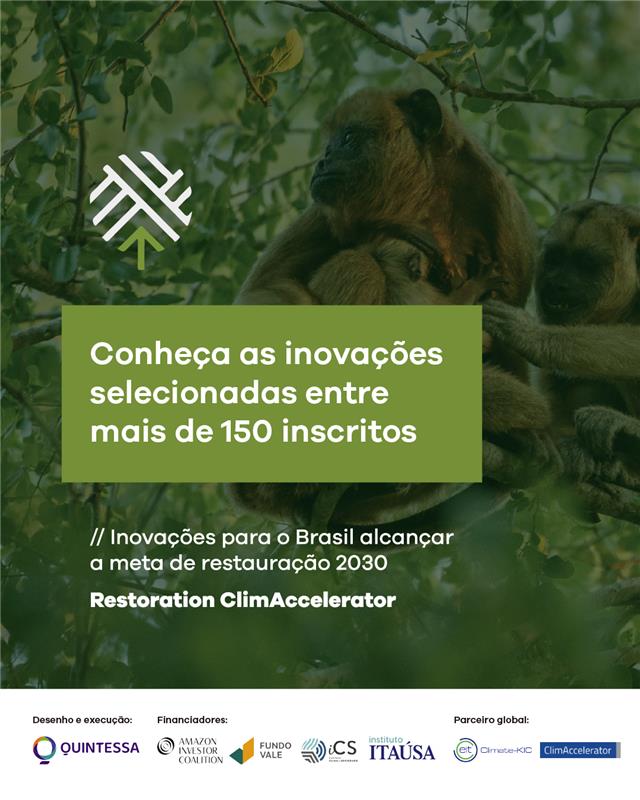Solutions drive technologies for forest and landscape restoration, with a focus on scale and social and environmental impact

Five initiatives offering innovative solutions for the forest restoration and production chain have been selected for the Restoration ClimAccelerator program, led by Quintessa with support from Fundo Vale and other strategic funders such as the Amazon Investor Coalition, iCS, the Itaúsa Institute and global partner Climate KIC. The program aims to foster innovations to address bottlenecks in the restoration chain, promoting greater efficiency, effectiveness and the inclusion of local communities, while contributing to Brazil’s goal of restoring 12 million hectares of forest by 2030. The current edition focuses on the Amazon and seeks to map, select and accelerate five innovations.
The program received more than 150 entries regarding innovations for various links in the restoration chain, such as R&D and bio-innovation for seeds and seedlings, land tenure regularization, remote sensing, technical training, and innovative financing and insurance mechanisms. Based on the entries, an intelligent map will be generated, presenting innovations in the sector. Thirty-five projects were pre-selected and advanced to the acceleration selection stage. The nomination and evaluation of innovations involved the active participation of prominent partners and funders in the restoration ecosystem, such as Capital for Climate (C4C), Regreen, Biomas, Systemica, the Vale Natural Reserve, Imaflora and the Belterra Institute.
The selection criteria included each solution’s alignment with the challenges of the restoration chain (focusing on the Amazon and community involvement), the relevance and potential impact of the innovation, the profile and experience of the entrepreneurial team, and the ability to add value to the respective challenge.
Check out the five initiatives selected – one in each of the program’s five broad areas.
- Land tenure and environmental regularization
Uirapuru (Pará): This initiative supports small farmers in the Amazon by providing automated, continuous diagnostics and action plans for land title regularization, delivered via AI on WhatsApp. The platform is in its early stages, but already connects more than 500 farmers and is conducting a pilot scheme in the Xingu River Basin, demonstrating adherence to the theme and local legitimacy.
- Seeds, seedlings and fertilizers
IVG Tech (São Paulo) – R&D and bio-innovation for seedlings: This startup is tackling the challenge of improving and diversifying genetic material for habitat restoration, focusing on the in vitro micropropagation of native species that are hard to germinate. It has already worked with major clients such as IPÊ and Biofílica. The solution has high potential for reducing costs for the restoration and biofuel chains.
- Remote sensing
Bioflore (Minas Gerais): This firm is working with remote sensing for environmental conservation and restoration, leveraging its expertise in biodiversity mapping and carbon monitoring. It offers feasibility studies, diagnostics, monitoring and customized services using various technologies, such as LiDAR sensors, drones and satellite imagery. It participated in XPrize Rainforest, representing Brazil in one of the largest global initiatives for mapping tropical forest biodiversity. It has also worked with Regreen, Pachama, Revalue, the Land Innovation Fund and IPÊ.
- Training and technical assistance
Alter do Chão Fire Brigade (Pará): This organization is focused on preventing and fighting fires, as well as integrated fire management, with a strong emphasis on training and local engagement. It seeks to expand its operations as a service provider, working with fire detection technologies such as the platform offered by climate tech company Um Grau e Meio.
- Financial mechanisms
Bluebell Index (São Paulo) – environmental asset index: This initiative seeks to value and monetize attributes such as soil, water and biodiversity through the creation of environmental tokens monitored via remote sensing and traded on a marketplace. Working with the Black Jaguar Foundation, it has mapped 200,000 hectares, and 74% of assets generated so far are in the Amazon.
